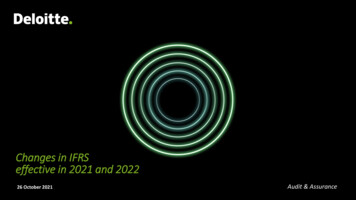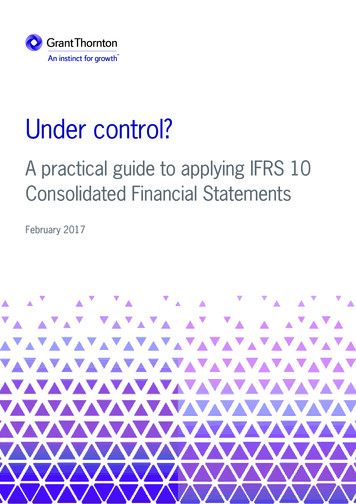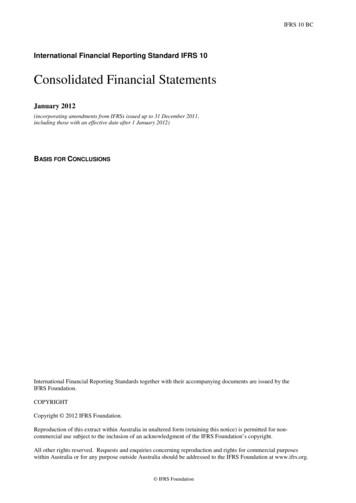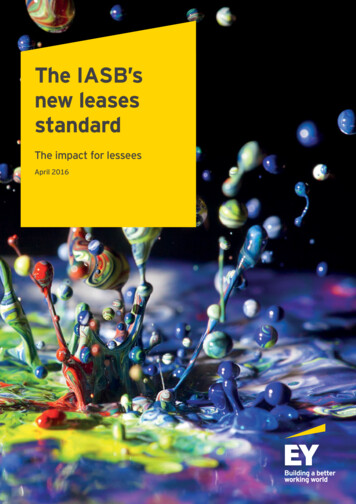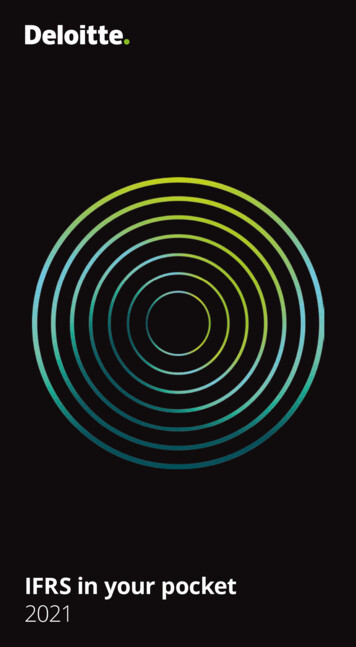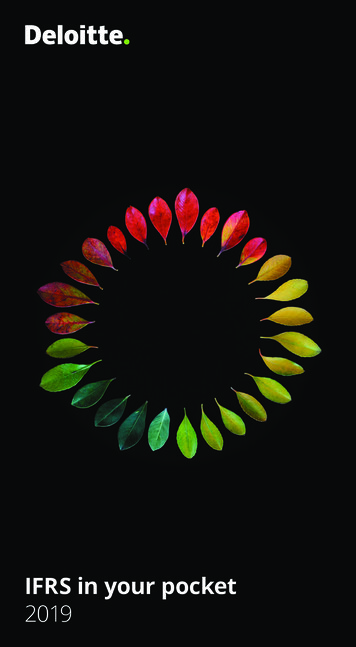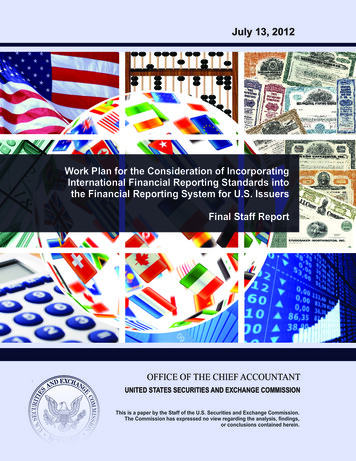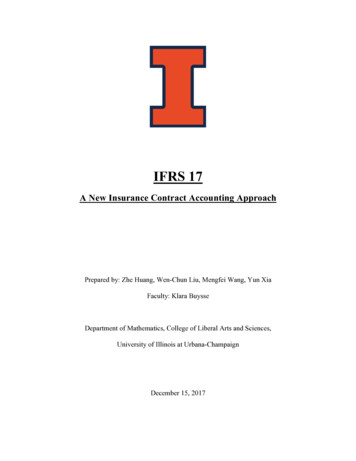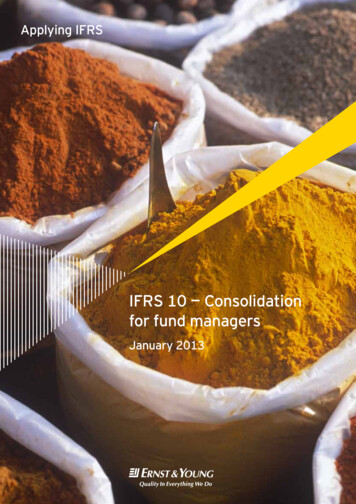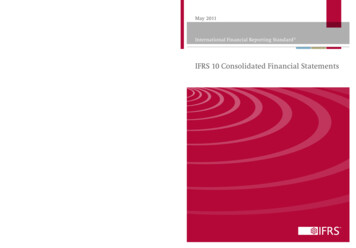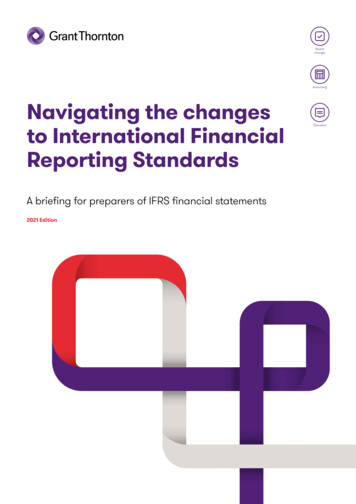
Transcription
RecentchangesAccountingNavigating the changesto International FinancialReporting StandardsA briefing for preparers of IFRS financial statements2021 EditionDiscussion
ContentsIntroduction 1Effective from 1 June 2020 26Effective dates of new Standards (based on Standards issued at 31 December 2020)2COVID-19-Related Rent Concessions (Amendment to IFRS 16)27Effective from 1 January 2019 3Effective from 1 January 2021 29IFRS 16 Leases 430Prepayment Features with Negative Compensation (Amendments to IFRS 9)8Interest Rate Benchmark Reform Phase 2 (Amendments to IFRS 9, IAS 39, IFRS 7, IFRS 4and IFRS 16)Long-term Interests in Associates and Joint Ventures (Amendments to IAS 28)11Effective from 1 January 2022 32Narrow Scope Amendments to IFRS Standards 33IFRIC 23 Uncertainty over Income Tax Treatments 12Effective from 1 January 2023 35Annual Improvements to IFRS 2015–2017 Cycle (Amendments to IAS 12, IAS 23, IFRS 3 and IFRS 11)14IFRS 17 Insurance Contracts 3641Plan Amendment, Curtailment or Settlement (Amendments to IAS 19)16Classification of Liabilities as Current or Non-Current (Amendments to IAS 1)Grant Thornton’s IFRS publications 42Effective from 1 January 2020 17Conceptual Framework for Financial Reporting 18Definition of a Business (Amendments to IFRS 3) 20Definition of Material (Amendments to IAS 1 and IAS 8) 22Interest Rate Benchmark Reform (Amendments to IFRS 9, IAS 39 and IFRS 7)24Important Disclaimer: This document has been developed as an information resource. It is intended as a guide only and the application of its contents to specific situations will depend on the particular circumstancesinvolved. While every care has been taken in its presentation, personnel who use this document to assist in evaluating compliance with International Financial Reporting Standards shouldhave sufficient training and experience to do so. No person should act specifically on the basis of the material contained herein without considering and taking professional advice. NeitherGrant Thornton International Ltd, nor any of its personnel nor any of its member firms or their partners or employees, accept any responsibility for any errors it might contain, whether causedby negligence or otherwise, or any loss, howsoever caused, incurred by any person as a result of utilising or otherwise placing any reliance upon this document.
IntroductionThis publication is designed to give preparers of IFRS financialstatements a high-level awareness of recent changes toInternational Financial Reporting Standards. It covers bothnew Standards and Interpretations that have been issued andamendments made to existing ones.What’s new in the 2021 editionThe 2021 edition of the publication has been updated forchanges to International Financial Reporting Standards(IFRS) that were published between 1 January 2020 and31 December 2020.The publication now covers 31 March 2020, 30 June 2020,30 September 2020, 31 December 2020 and 31 March 2021financial year ends.ContentsThe effective dates table on the next page lists all the changescovered in the publication, their effective dates, and the pagein the publication on which the appropriate summary can befound.How to use the publicationIdentifying the changes that will affect youThe effective dates table has been colour coded to help entitiesplanning for a specific financial reporting year end, andidentifies: changes mandatorily effective for the first time changes not yet effective changes already in effect.Where a change is not yet mandatorily effective for aparticular year end, it may still be possible for an entityto adopt it early (depending on local legislation and therequirements of the particular change in concern).Where a change has been made but an entity is yet to applyit, certain disclosures are required to be made under IAS 8‘Accounting Policies, Changes in Accounting Estimates andErrors’. Disclosures required include the fact that the new oramended Standard or Interpretation has been issued but ithas not yet been applied, and known or reasonably estimableinformation relevant to assessing its possible impact on thefinancial statements in the period of initial application.Identifying the commercial significance of the changes in thepublicationFor each change covered in the publication, we have includeda box on its commercial implications. These sections focus ontwo questions: how many entities will be affected? what will be the impact on affected entities?A traffic light system indicates our assessment of the answersto these questions.Other Grant Thornton International publicationsWhere appropriate, references have been made to otherGrant Thornton International publications that providemore detailed information on the changes discussed in thispublication. A list of other publications is provided on pages 42to 44 and should you require further assistance, please contactyour local IFRS contact.Grant Thornton International LtdJanuary 2021‘ The publication now covers31 March 2020, 30 June 2020,30 September 2020, 31 December2020 and 31 March 2021 financialyear ends.’Navigating the changes to IFRS – 2021 Edition 1
Effective dates of newStandards1 January 2019 IFRS 9Prepayment Features with Negative Compensation(Amendments to IFRS 9)1 January 2019 IAS 28Long-term Interests in Associates and Joint Ventures(Amendments to IAS 28)1 January 2019 IFRIC 23Uncertainty over Income Tax Treatments1 January 2019 IAS 12, IAS 23,IFRS 3 andIFRS 11Annual Improvements to IFRS 2015-2017 Cycle1 January 2019 IAS 19Plan Amendment, Curtailment or Settlement(Amendments to IAS 19)1 January 2019 VariousAmendments to References to the Conceptual Frameworkin IFRS Standards1 January 2020 IFRS 3Definition of a Business (Amendments to IFRS 3)1 January 2020IAS 1 and IAS 8Definition of Material (Amendments to IAS 1 and IAS 8)1 January 2020 IFRS 9, IAS 39and IFRS 7Interest Rate Benchmark Reform (Amendments toIFRS 9, IAS 39 and IFRS 7)1 January 2020 IFRS 16COVID-19-Related Rent Concessions (Amendment to IFRS 16)1 June 2020 VariousInterest Rate Benchmark Reform Phase 2 (Amendments toIFRS 9, IAS 39, IFRS 7, IFRS 4 and IFRS 16)1 January 2021 IFRS 3References to the Conceptual Framework (Amendmentsto IFRS 3)1 January 2022 IAS 16Proceeds before intended use (Amendments to IAS 16)1 January 2022 IAS 37Onerous Contracts – Cost of Fulfilling a Contract(Amendments to IAS 37)1 January 2022 IFRS 1, IFRS 9,IFRS 16 andIAS 41Annual Improvements to IFRS Standards 2018-2020 Cycle(Amendments to IFRS 1, IFRS 9, IFRS 16, IAS 41)1 January 2022 IFRS 17Insurance Contracts31 January 2023 IFRS 4Extension of the Temporary Exemption from Applying IFRS 9(Amendments to IFRS 4)1 January 2023 IAS 1Classification of Liabilities as Current or Non-current(Amendments to IAS 1)1 January 2023 Key:Change already in mandatory effectChange effective for the first timeChange not yet effective2 Navigating the changes to IFRS – 2021 EditionAlready in manadatory effectAlready in manadatory effectEffective for the firsttimeNot yet effectiveEffective for the first timeNot yet effectiveEffective for the firsttimeEffective for the first timeNot yet effectiveNot yet effectiveEffective for the first timeNot yet effective124The colour coding gives an indication of when the changes covered in the publication become effective in relation to the specific financial reporting year ends set out in the table.Notes1 Entities that early adopt IFRS 16 must apply IFRS 15 before or on the same date.2 This amendment has been issued to to help entities during the COVID-19 pandemic. It therefore is highly likely to be adopted early.3 Includes ‘Amendments to IFRS 17’ issued in June 2020.4 Entities that early adopt IFRS 17 must apply IFRS 9 before or on the same date.31 Mar 2021year endLeases31 Dec 2020year endIFRS 1630 Sep 2020year endEffective foraccounting periodsbeginningon or after30 Jun 2020year endTitle of Standard or InterpretationEarlyApplication?Standard31 Mar 2020year endBased on Standards issued at 31 December 2020
Effective from 1 January 2019The Standards mentioned on pages 4 to 16 are effective foraccounting periods beginning on or after 1 January 2019.The Standards are: IFRS 16 Leases Prepayment Features with Negative Compensation(Amendments to IFRS 9) Long-term Interests in Associates and Joint Ventures(Amendments to IAS 28) IFRIC 23 Uncertainty over Income Tax Treatments Annual Improvements to IFRS 2015-2017 Cycle Plan Amendment, Curtailment or Settlement(Amendments to IAS 19)Navigating the changes to IFRS – 2021 Edition 3
IFRS 16 LeasesIFRS 16 is the result of the IASB’s long-running project tooverhaul lease accounting, representing the first major changeto lease accounting in over 30 years. The new Standardreplaces IAS 17 ‘Leases’ along with three Interpretations(IFRIC 4 ‘Determining whether an Arrangement containsa Lease’, SIC 15 ‘Operating Leases-Incentives’ and SIC 27‘Evaluating the Substance of Transactions Involving the LegalForm of a Lease’).IFRS 16 will require lessees to account for leases ‘on-balancesheet’ by recognising a ‘right-of-use’ asset and a lease liability.For many businesses, however, exemptions for short-term leasesand leases of low value assets will greatly reduce the impact.IFRS 16 also: changes the definition of a lease sets requirements on how to account for the asset andliability, including complexities such as non-lease elements,variable lease payments and option periods changes the accounting for sale and leasebackarrangements largely retains IAS 17’s approach to lessor accounting introduces new disclosure requirements.The table summarises the main changes at a glance:IFRS 16 Leases at a glanceIssueOther factors to considerWho is affected? entities that lease assets as a lessee or a lessorWhat’s the impact onlessees? all leases will be accounted for ‘on-balance sheet’, other than short-term and low value asset leases lease expense will typically be ‘front-loaded’ lease liability will exclude:– option periods unless exercise is reasonably certain– contingent payments that are linked to sales/usage and future changes in an index/rateWhat’s the impact onlessors? only minor changes from the current Standard – IAS 17Are there other changes? a new definition of a lease will result in some arrangements previously classified as leases ceasing to be so,and vice versa new guidance on sale and leaseback accounting new and different disclosuresWhen are the changeseffective? annual periods beginning on or after 1 January 2019 various transition reliefs4 Navigating the changes to IFRS – 2021 Edition
ScopeIFRS 16 applies to all leases for both the lessee and lessor, except for a few scope exclusions. These exclusions, some of which aresimilar to IAS 17’s, are summarised in the table:Scope exclusions from IFRS 16Scope exclusionStandard to applyLeases to explore for or use minerals, oil, natural gas and similarnon-regenerative resourcesNone specified. Depending on the circumstances IFRS 6 ‘Explorationfor and Evaluation of Mineral Resources’ or IAS 38 ‘Intangible Assets’might applyLeases of biological assets in scope of IAS 41 held by a lesseeIAS 41 ‘Agriculture’Service concession arrangements in scope of IFRIC 12IFRIC 12 ‘Service Concession Arrangements’Licences of intellectual property granted by a lessor in scopeof IFRS 15IFRS 15 ‘Revenue from Contracts with Customers’Rights held under licensing agreements in scope of IAS 38 for itemssuch as motion picture films, video recordings, plays, manuscripts,patents and copyrights*IAS 38 ‘Intangible Assets’* for leases of other types of intangible asset a lessee is permitted to apply IFRS 16 but not required to do soDefinition of a leaseBecause the new lease accounting model brings many moreleases ‘on-balance sheet’, the evaluation of whether a contractis (or contains) a lease becomes even more important than itis today.Under IFRS 16 a lease is defined as: ‘a contract, or part of acontract, that conveys the right to use an asset (the underlyingasset) for a period of time in exchange for consideration’. Acontract is, or contains, a lease if: fulfilment of the contract depends on the use of an identifiedasset; and the contract conveys the right to control the use of theidentified asset for a period of time in exchange forconsideration.In practice, the main impact of IFRS 16’s new definition andsupporting guidance is likely to be on contracts that are not inthe legal form of a lease but involve the use of a specific assetand may therefore contain a lease.Lessee accountingSubject to the optional accounting simplifications discussedbelow, a lessee will be required to recognise its leases on thebalance sheet. This involves recognising: a ‘right-of-use’ asset; and a lease liability.The lease liability is initially measured as the present valueof future lease payments. For this purpose, lease paymentsinclude fixed, non-cancellable payments for lease elements,amounts due under residual value guarantees, certain types ofcontingent payments and amounts due during optional periodsto the extent that extension is ‘reasonably certain’.In subsequent periods, the right-of-use asset is accounted forsimilarly to a purchased asset and depreciated or amortised.The lease liability is accounted for similarly to a financialliability using the effective interest method.Navigating the changes to IFRS – 2021 Edition 5
‘IFRS 16 will require lessees toaccount for leases ‘on-balancesheet’ by recognising a ‘righof-use-asset’ and a leaseliability.’Optional accounting simplificationsIFRS 16 provides important reliefs or exemptions for: short-term leases (a lease is short-term if it has a lease termof 12 months or less at the commencement date) low-value asset leases (the assessment of value is basedon the absolute value of the leased asset when new andtherefore requires judgement. In the Basis for Conclusionswhich accompanies the Standard, however, the IASB notesthat they had in mind leases of assets with a value whennew of around US 5,000 or less).If these exemptions are used, the accounting is similar tooperating lease accounting under the current Standard IAS 17‘Leases’. Lease payments are recognised as an expense on astraight-line basis over the lease term or another systematic basis(if more representative of the pattern of the lessee’s benefit).If an entity (the seller-lessee) transfers an asset to anotherentity (the buyer-lessor) and leases that asset back fromthe buyer-lessor, both the seller-lessee and the buyer-lessordetermine whether the transfer qualifies as a sale. Thisdetermination is based on the requirements for satisfying aperformance obligation in IFRS 15.In November 2020, the IASB issued an exposure draft lookingto expand the requirements of sale and leaseback accountingin IFRS 16, so changes to these current requirements areanticipated.For more information, please refer toour special edition of IFRS News onMajor reforms to globalIFRS 16 ‘Leases’. The special editionlease accountingexplains the key features of the newStandard and provides practical insightsinto its application and impact. Toobtain your copy, please get in touchwith the IFRS contact in your localGrant Thornton office or go to -newsspecial-edition-on-ifrs-16/.s n gew io nN dit untiRS l E coIF cia Ace eSp easLonLessor accountingIFRS 16’s requirements for lessor accounting are similar toIAS 17’s. In particular: the distinction between finance and operating leases isretained the definitions of each type of lease, and the supportingindicators of a finance lease, are substantially the same asIAS 17’s the basic accounting mechanics are also similar, butwith some different or more explicit guidance in a fewareas. These include variable payments; sub-leases; leasemodifications; the treatment of initial direct costs; and lessordisclosures.Sale and leaseback accountingIFRS 16 makes significant changes to sale and leasebackaccounting.IFRS News Special EditionFebruary 2016The IASB has published IFRS 16 ‘Leases’ completing itslong-running project on lease accounting.This special edition of IFRS News explains the key featuresof the new Standard and provides practical insights intoits application and impact.‘The new Standard replaces IAS 17 ‘Leases’ along with threeInterpretations (IFRIC 4 ‘Determining whether an Arrangementcontains a Lease’, SIC 15 ‘Operating Leases-Incentives’ andSIC 27 ‘Evaluating the Substance of Transactions Involvingthe Legal Form of a Lease’).’6 Navigating the changes to IFRS – 2021 Edition
Effective date and transitionIFRS 16 is effective for annual periods beginning on or after1 January 2019 with earlier application permitted.In terms of transition, IFRS 16 provides lessees with achoice between two broad methods: full retrospective application – with restatement ofcomparative information in accordance with IAS 8‘Accounting Policies, Changes in Accounting Estimatesand Errors’ partial retrospective application – without restatingcomparatives. Under this approach the cumulative effectof initially applying IFRS 16 is recognised as an adjustmentto equity at the date of initial application. If a lesseechooses this method, a number of more specific transitionrequirements and optional reliefs also apply.AccountingTaxInsights into IFRS 16GlobalUnderstanding the discount rateUnder IFRS 16 ‘Leases’, discount rates are used to determinethe present value of the lease payments used to measurea lessee’s lease liability. Discount rates are also used todetermine lease classification for a lessor and to measure alessor’s net investment in a lease.For lessees, the lease payments are required to be discountedusing: the interest rate implicit in the lease (IRIL), if that rate can bereadily determined, or the lessee’s incremental borrowing rate (IBR).For lessors, the discount rate will always be the interest rateimplicit in the lease.The interest rate implicit in the lease is defined in IFRS 16as ‘the rate of interest that causes the present value of (a)the lease payments and (b) the unguaranteed residual valueto equal the sum of (i) the fair value of the underlying assetand (ii) any initial direct costs of the lessor.’The lessee’s incremental borrowing rate is defined inIFRS 16 as ‘the rate of interest that a lessee would have topay to borrow over a similar term, and with a similar security,the funds necessary to obtain an asset of a similar value tothe right-of-use asset in a similar economic environment’.The incremental borrowing rate is determined on thecommencement date of the lease. As a result, it will incorporatethe impact of significant economic events and other changesin circumstances arising between lease inception andcommencement.A lessee will need to determine a discount rate for virtuallyevery lease to which it applies the lessee accounting modelin IFRS 16. However, a discount rate may not need to bedetermined for a lease if: a lessee applies the recognition exemption for either a shortterm or a low-value asset lease all lease payments are made on (or prior to) thecommencement date of the lease, or all lease payments are variable and not dependent on anindex or rate (eg, all lease payments vary based on sales orusage).The interest rate implicit in the lease may be similar to thelessee’s incremental borrowing rate in many cases. Both ratesconsider the credit risk of the lessee, the term of the lease, thesecurity and the economic environment in which the transactionoccurs.Our Insights into IFRS 16 series looksat key areas of the new Standard andaims to provide assistance in preparingfor IFRS 16. The key areas covered in theseries are: Understanding the discount rate Interim periods Definition of a lease Lease term Transition choices Sale and leaseback accounting Lease payments Presentation and disclosure Lease incentivesCommercial significanceMostNumber ofentities affectedIFRS 16 will affect most companies that report under IFRS andare involved in leasing.HighImpact onaffected entitiesIFRS 16 will have a substantial impact on the financialstatements of lessees of property and high value equipment.Bringing all leases on-balance sheet is controversial. The IASBtherefore made compromises to reduce the controversy, inparticular exemptions for short-term and low value asset leases.As a result businesses that lease only assets such as printersand laptops will face only a limited impact. For businessesthat lease ‘big-ticket’ assets, such as property and high-valueequipment, this will however be a major change.To obtain your copy, please get in touch with the yourlocal IFRS contact or go to ating the changes to IFRS – 2021 Edition 7
Prepayment Features withNegative Compensation(Amendments to IFRS 9)In October 2017, the IASB published ‘Prepayment Featureswith Negative Compensation (Amendments to IFRS 9)’.The amendments allow companies to measure particularprepayable financial assets with negative compensation atamortised cost or at fair value through other comprehensiveincome – instead of measuring those assets at fair valuethrough profit or loss (FVTPL).The amendments also include clarifications to the modificationor exchange of a financial liability that does not result inderecognition.After IFRS 9 was issued, the IFRS Interpretations Committeereceived a request on how to apply the IFRS 9 requirementsfor recognising and measuring financial instruments tocertain debt instruments where the borrower is permitted toprepay the instrument at an amount that could be less thanthe unpaid principal and interest owed. Such a prepaymentfeature is often referred to as including potential ‘negativecompensation’.Under the then existing requirements of IFRS 9, an entity wouldhave measured a financial asset with negative compensationat FVTPL as the ‘negative compensation’ feature would havebeen viewed as introducing potential cash flows that were notsolely payments of principal and interest.However, to improve the usefulness of the information provided,in particular on the instrument’s effective interest rate andexpected credit losses, the IASB issued the amendments so thatentities will now be able to measure some prepayable financialassets with negative compensation at amortised cost.8 Navigating the changes to IFRS – 2021 Edition‘The change to the accountingfor a modification or exchangeof a financial liability that doesnot result in derecognition iseffective from 2018 as this textmerely clarifies the existingStandard as opposed toamending it.’
Another issue – Modification or exchange of a financialliability that does not result in derecognitionConcurrent with the amendment to IFRS 9 for prepaymentfeatures with negative compensation, the IASB discussedthe accounting for a modification or exchange of a financialliability measured at amortised cost that does not result in thederecognition of the financial liability. Specifically, the IASBconsidered whether, when applying IFRS 9, an entity shouldrecognise any adjustment to the amortised cost of the financialliability arising from such a modification or exchange in profitor loss at the date of the modification or exchange.The IASB concluded that no change needed to be made tothe Standard itself but has clarified the existing position byadding text to the Basis for Conclusions on IFRS 9 in theseamendments.To summarise, the IASB believes IFRS 9 provides an adequatebasis for an entity to account for modifications and exchangesof financial liabilities that do not result in derecognition. Thetext which has been added in the amendments highlightsthat the requirements in IFRS 9 for adjusting the amortisedcost of a financial liability when a modification (or exchange)does not result in the derecognition of the financial liabilityare consistent with the requirements for adjusting the grosscarrying amount of a financial asset when a modificationdoes not result in the derecognition of the financial asset.Those requirements state when contractual cash flows ofa financial asset are renegotiated or otherwise modifiedand the renegotiation or modification does not result in thederecognition of that financial asset, an entity shall recalculatethe gross carrying amount of the financial asset and shallrecognise a modification gain or loss in profit or loss.The change to the accounting for a modification or exchangeof a financial liability that does not result in derecognition iseffective from 2018 as this text merely clarifies the existingStandard as opposed to amending it.‘To summarise, the IASB believes that IFRS 9 provides anadequate basis for an entity to account for modificationsand exchanges of financial liabilities that do not result inderecognition.’Navigating the changes to IFRS – 2021 Edition 9
Ironically, the ‘other issue’ clarifying the accounting for amodification or exchange of a financial liability that does notresult in derecognition may well result in the most significantchange in accounting as modification gains and losses will nowbe recognised immediately in profit or loss in such situations.‘Prepayment Features with Negative Compensation –Amendments to IFRS 9’ is effective for annual periods beginningon or after 1 January 2019, with earlier application permitted.Commercial significanceSomeNumber ofentities affectedThe amendments will have most relevance to financialinstitutions who hold these types of financial instruments,although it is possible that some other entities will be affected.HighImpact onaffected entitiesThese amendments are important to financial institutions, aswithout them they would have had to account for what areessentially debt-type financial assets at fair value as opposedto amortised cost, which may not have provided the most usefulinformation to users.The ‘other issue’ included in these amendments could have aneven more significant impact and must be applied at the sametime IFRS 9 is applied.‘Ironically, the ‘other issue’ clarifying the accounting fora modification or exchange of a financial liability that doesnot result in derecognition may well result in the mostsignificant change in accounting as modification gains andlosses will now be recognised immediately in profit or lossin such situations.’10 Navigating the changes to IFRS – 2021 Edition
Long-term Interests inAssociates and JointVentures (Amendmentsto IAS 28)In October 2017 the IASB published ‘Investments in Associatesand Joint Ventures (Amendments to IAS 28)’ clarifying thatcompanies account for long-term interests in an associate orjoint venture – to which the equity method is not applied – usingIFRS 9 ‘Financial Instruments’. This includes long-term intereststhat, in substance, form part of the entity’s net investment in anassociate or joint venture.IFRS 9 excludes interests in associates and joint venturesaccounted for in accordance with IAS 28. However, somestakeholders expressed an opinion that it was not clear whetherthat exclusion applies only to interests in associates and jointventures to which the equity method is applied or whether itapplies to all interests in associates and joint ventures.In the amendments, the IASB clarifies that the exclusion inIFRS 9 applies only to interests accounted for using the equitymethod. Therefore, an entity applies IFRS 9 to other interestsin associates and joint ventures, including long-term intereststo which the equity method is not applied and which, insubstance, form part of the net investment in those associatesand joint ventures.The IASB has also published an example that illustrates howentities apply the requirements in IFRS 9 and IAS 28 to longterm interests in an associate or joint venture.Commercial significanceSomeNumber ofentities affectedThe amendments will impact entities that have interests inassociates and joint ventures to which the equity method isapplied.HighImpact onaffected entitiesThe amendment is significant as it means holdings in debttype instruments issued by an associate or joint venture will besubject to IFRS 9’s impairment requirements.‘IFRS 9 excludes interests inassociates and joint venturesaccounted for in accordancewith IAS 28.’Navigating the changes to IFRS – 2021 Edition 11
IFRIC 23 Uncertainty overIncome Tax TreatmentsThe IFRS Interpretations Committee (IFRIC) publishedIFRIC 23 ‘Uncertainty over Income Tax Treatments’, specifyinghow entities should reflect uncertainty in accounting forincome taxes.IAS 12 ‘Income Taxes’ specifies how to account for current anddeferred tax but not how to reflect the effects of uncertainty.IFRIC 23 addresses this previous lack of guidance.IFRIC 23 addresses uncertainty over how tax treatments shouldaffect the accounting for income taxes. IFRIC observed therewas diversity in practice for various issues on the recognitionand measurement of a tax liability or asset in circumstanceswhere there is uncertainty in the application of the tax lawin concern. The table illustrates the main issues that areaddressed by the Interpretation.Main issues addressed by IFRIC 23IssueProposalWhen and how the effect of uncertainty over income taxtreatments should be included in the determination oftaxable profit (tax loss), tax bases, unused tax losses,unused tax credits and tax rates an entity is required to consider whether it is probable that a taxationauthority will accept an uncertain tax treatment if it is, the entity would determine taxable profit (tax loss), tax bases, unusedtax losses, unused tax credits or tax rates consistently with the tax treatmentused or planned to be used in its income tax filings if the entity concludes it is not probable the taxation authority will accept anuncertain tax treatment, it uses either the most likely amount or the expectedvalue in determining taxable profit (tax loss), tax bases, unused tax losses,unused tax credits and tax rates (depending on which method is expected tobetter predict the resolution of the unce
2 Navigating the changes to IFRS – 2021 Edition Effective dates of new Standards Based on Standards issued at 31 December 2020 The colour coding gives an indication of when the changes covered in the publication become effective in relation to the spe
